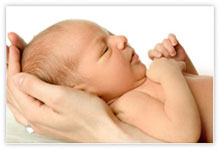 |
Cerebral palsy is a group of non-progressive, non contagious motor condition that cause physical disability as described by loss or impairment of motor function.
The brain damage is caused by brain injury or abnormal development of the brain occurs while a child’s brain is still developing i.e before birth, during the birth or immediately after the birth. |
Cerebral palsy affects body movements, muscle control, muscle coordination, muscle tone, reflex, posture and balance. It also impacts the fine motor skills,gross motor skills and oral motor functioning. Children with cerebral palsy may suffer problems with posture, balance, coordination, walking, speech, swallowing, and many other functions.
Cerebral palsy may accompany certain associative features such as mental retardation, seizures, breathing problems, learning disabilities, bladder and bowel control problems, skeletal deformities, eating difficulties, dental problems, digestive problems, and hearing and vision problems.
The severity of these problems varies widely, from very mild and subtle to very profound.
Cerebral palsy may be classified into various types:
 Spastic cerebral palsy : Types of Spastic cerebral palsy
Spastic cerebral palsy : Types of Spastic cerebral palsy
-
Hemiplegia - One side of the body either left or right gets affected
-
Diplegia - Lower body extremity affected with little to no upper body spasticity
-
Monoplegia - Single limb affected either upper limb or lower limb
-
Triplegia - Any three limbs affected
-
Quadriplegia - All the four limbs more or less equally affected
This is the most common type of CP, accounting for about 70-80% of cases.
 Flaccid cerebral palsy- cerebellum part of the brain is affected. This type of cerebral palsy is accompanied by a decrease in muscle tone, producing flaccidity in the muscles.
Flaccid cerebral palsy- cerebellum part of the brain is affected. This type of cerebral palsy is accompanied by a decrease in muscle tone, producing flaccidity in the muscles.
 Athetoid cerebral palsy- Extrapyramidal part of the brain is affected. The person has uncontrolled movements that are slow and writhing. The movements can affect any part of the body, including the face, mouth and tongue. About 10-20% of cerebral palsy cases are of this type.
Athetoid cerebral palsy- Extrapyramidal part of the brain is affected. The person has uncontrolled movements that are slow and writhing. The movements can affect any part of the body, including the face, mouth and tongue. About 10-20% of cerebral palsy cases are of this type.
 Ataxic cerebral palsy- This type affects balance and coordination. Depth perception is usually affected. If the person can walk, the gait is probably unsteady. He or she has difficulty with movements that are quick or require a great deal of control, such as writing. About 5-10% of cases of cerebral palsy are of this type.
Ataxic cerebral palsy- This type affects balance and coordination. Depth perception is usually affected. If the person can walk, the gait is probably unsteady. He or she has difficulty with movements that are quick or require a great deal of control, such as writing. About 5-10% of cases of cerebral palsy are of this type.
 Mixed cerebral palsy- This is a mixture of different types of cerebral palsy. A common combination is spastic and athetoid.
Mixed cerebral palsy- This is a mixture of different types of cerebral palsy. A common combination is spastic and athetoid.
Intervention
Treatment for cerebral palsy is a lifelong multi-dimensional process focused on the maintenance of associated conditions. In order to be diagnosed with cerebral palsy the damage that occurred to the brain must be non-progressive and not disease like in nature. The appearance of that damage will change as the brain and body develop, but the actual damage to the brain will not increase. Treatment in the life of cerebral palsy is the constant focus on preventing the damage in the brain from prohibiting healthy development on all levels. The brain, up to about the age of 8, is not concrete in its development. It has the ability to re-organize and re-route many signal paths that may have been affected by the initial trauma; the earlier it has help in doing this the more successful it will be. Various forms of therapy are applied to improve the symptoms of multiple disabilities. In general, the earlier treatment begins the better chance children have of overcoming developmental disabilities or learning new ways to accomplish the tasks that challenge them. The earliest proven intervention occurs during the infant's recovery in the neonatal intensive care unit (NICU). Course of treatment at Romasis may include one or more of the following: physical therapy; occupational therapy; speech therapy
Integrated therapy
Physiotherapy
Is designed to encourage the patient to build a strength base for improved gait and volitional movement, together with stretching programs to limit contractures. Many experts believe that life-long physiotherapy is crucial to maintain muscle tone, bone structure, and prevent dislocation of the joints.
Occupational therapy
helps adults and children maximize their function, adapt to their limitations and live as independently as possible.
Speech therapy
Helps control the muscles of the mouth and jaw, and helps improve communication. Just as CP can affect the way a person moves their arms and legs, it can also affect the way they move their mouth, face and head. This can make it hard for the person to breathe; talk clearly; and bite, chew and swallow food. Speech therapy often starts before a child begins school and continues throughout the school years.